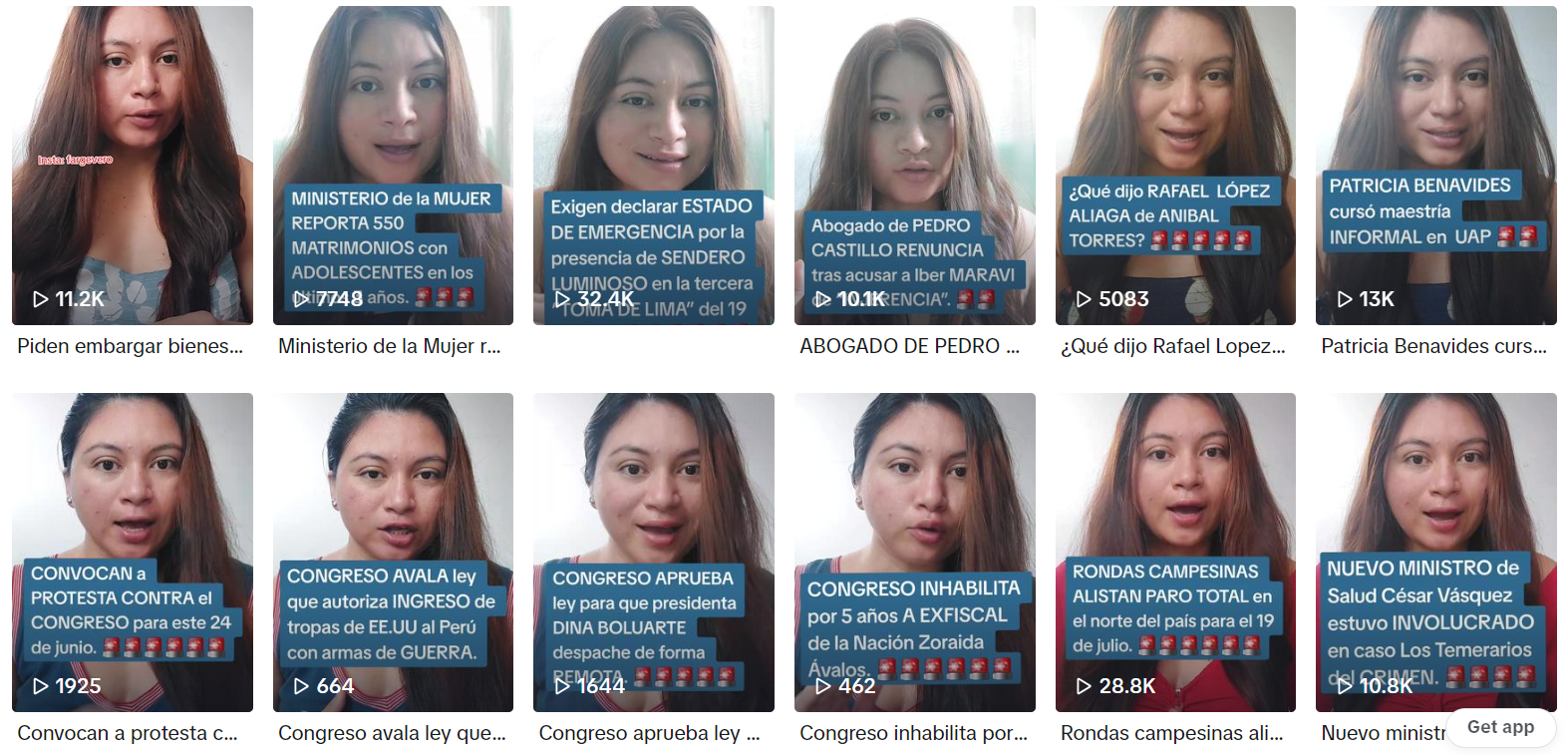These voices from Peru and Kenya explain how they deliver the news on TikTok

Otra Cara’s TikTok account.
The concept of citizen journalism is not a new one. Ever since the invention of the printing press, non-professional writers have shared information through newsletters, pamphlets and brochures.
The coming of age of the internet made it possible for anyone to share information to the world within seconds. Citizen journalists have been able to report live from breaking news situations such as the Arab Spring or Hurricane Katrina. They have even partnered with traditional media outlets to get to places mainstream media is unable to access.
Does this trend make journalism better by featuring new voices from marginalised communities or does it make it worse by transforming it into something perhaps less professional? This is the question editors and experts are grappling with as news consumption evolves into a platform-dominated environment where independent voices are more prevalent than ever.
Survey data from our Digital News Report 2023 suggests that in networks like TikTok, Instagram and Snapchat, audiences pay more attention to personalities, influencers and ordinary people than to mainstream journalists or news outlets when it comes to news.
This is particularly salient as more and more people, primarily young people, are basing most of their news diets on social media. Zooming in on TikTok, the fastest-growing social media for news, our data shows that usage of the platform for news is particularly high in countries such as Peru, Thailand and Kenya.
I wanted to explore what kind of news content was being consumed on TikTok in these countries and also how these kinds of news influencers saw what they did. I spoke with TikTok content creators from Peru and Kenya, as well as with a researcher on non-professional journalism for this piece to explore the rise of a new form of citizen journalism that’s become a significant news source for many.
New voices in Peru and Kenya
When Lima residents Verónica Farge Angulo and José Carlos Castillo finished their degrees in social communication, they saw an opportunity to keep doing journalism in an increasingly competitive job market through TikTok. “In Peru, politics changes a lot: there is always something new happening. There is always something that surprises you,” says Farge Angulo. “We decided to make a news channel on TikTok because we were also seeing how the platform is growing.”
TikTok has one of the highest rates of usage in Peru, with more than 18 million of its population of 33 million having the app on their phones and 30% of our Digital News Report 2023 respondents using it for news.
In August 2022 Farge Angulo and Castillo launched Otra Cara, a news outlet based on TikTok and entirely run from their respective living rooms, with Farge Angulo in front of the camera, and Castillo Rodas mostly behind the scenes. At the time of this writing, Otra Cara had a follower count of more than 32,000.
@otracara.pe ♬ sonido original - OtraCara
“[What] differentiates us from traditional media is that we are neither in favour of one side nor in favour of the other. We are neither left nor right. We have a neutral position,” says Castillo. “If there is an explosive news item about commerce, for example, this news is not published in right-wing media or it is published in a more lukewarm way.” Despite Castillo’s characterisation, a number of the videos they have published showcase criticisms of right-wing politicians.
Peru is in the midst of a politically tumultuous era. The opposition-controlled Congress successfully ousted the new president, Pedro Castillo, after he attempted a self-coup by establishing an emergency government, reorganising the judiciary, and calling for a new constitution following several attempts to impeach him.
The mainstream press, mostly opposed to Castillo’s government, supported the newly established administration, which aligned itself with conservative parties that seek to protect markets and preserve conservative policies.
“Most of the press dedicated themselves to attacking [the President]. So we asked ourselves, ‘Is everything they say about the President true?’,” says Castillo. “And at that time there was a great variety of news about politics practically every day so we took advantage of that situation to make inroads.”
Similarly, Justine Wanda, a comedian in Kenya, started her TikTok account after seeing the political polarisation of news in traditional media outlets. “In Kenya, we have news where it is kind of just in your face,” says Wanda. She says that stories are usually framed or consumed within the political sides of the country: you’re either with the opposition or with the government. "When you watch the news, people just feel like either you like a certain story and you're taking the side of the opposition or you hate it and you’re taking the side of the government. That sometimes doesn’t paint the full picture.”
Her TikTok page, Fake Woke with Justine, is a satirical take on the news. As a comedian, she makes deadpan rapid-fire jokes based on the news of the day, flashing the news article she is discussing. You can say it’s The Daily Show reimagined for the TikTok age.
@fakewokewithjustine Nigerian thieves ruining flights #tiktoknigeria #flights ♬ original sound - Watch FWWJ
While she doesn't consider herself a journalist, many of her 13,000 followers turn to her for her take on the news. One of the comments in her video about Kenya’s 2023 Finance Bill, which seeks to amend various laws relating to taxes to increase government revenues from taxes collected, says: “I love how you explain the financial-political situation in our country...I don't watch the news so this is very enlightening.✨”
Wanda says she understands her audience, which is mostly between the ages of 19 to 34 and is unlikely to sit down to watch an evening newscast. “I thought this would be a great way to connect younger people who do not necessarily watch the news but want to know what's happening in a way that doesn’t overwhelm them,” she says. “If I line it with a joke, people are like, ‘Okay, I'm more likely to watch more news if I feel like it appeals to me.’”
Fake Woke With Justine TikTok account.
Leonie Wunderlich, a Junior Researcher at the Leibniz Institute for Media Research who studies the role of non-journalistic actors in news consumption behaviours of young people, says that one of the reasons why young audiences are attracted to non-journalistic actors is the demographic similarities to the creators and their savviness with the platform.
“It’s about how [the news] is presented and if the news is delivered by a news influencer or an anchor figure, it should be a person who is also young and who young people can identify with,” Wunderlich says.
Blurring the lines
Just like Wanda, Farge Angulo, and Castillo Rodas, there are thousands of content creators who focus on the news. However, unlike Wanda, Farge Angulo, and Castillo Rodas, many do not take the steps necessary to fact-check what they discuss. Some spread fake news on purpose, or take a distinctly biased approach masked as reporting.
This has made some of the content creators I spoke to experience pushback from certain users. Wanda says a lot of older users are not receptive to her content and criticise it. Some say she should be more respectful of the political figures she discusses on her videos and suggest she is diluting journalism.
“Even if there’s pushback from people who are older and who think there's something that needs to be protected, there are people who are in those institutions [Kenyan newsrooms] who have the power and the resources to go and do the work to make sure that they’re not pushing propaganda,” says Wanda. “Those are the people who need to uphold the institution of journalism, not a comedian on the Internet.”
“I don't say I'm a journalist or anything,” she says, “I want to make people laugh and be a little aware of what's going on around them.”
Similarly to Wanda, who fact-checks every news story she discusses, the team at Otra Cara say they uphold journalistic standards. Although sometimes confused for “alternative journalists” who parrot political attacks, they say that audiences can often tell the difference between partisan influencers and creators like them.
“Our news is all serious, which is very different from what influencers do,” says Farge Angulo. “It's the way we break the news, it's a little more serious and for that, you can see that it's a serious outlet.”
Wunderlich from the Leibniz Institute says that her research shows audiences are usually able to see the difference between information and personal opinion, adding that young audiences are attracted to hearing people’s opinions about current affairs. For her, while the line between journalist and news influencer is further blurring, that’s not necessarily a bad thing.
“I don't really see a big difference because these are people who report on important topics, they communicate with their community, they try to fact-check what they say, and they try to keep in mind these journalistic standards,” says Wunderlich. “Their approach or what they want to achieve is very similar to journalism because they want to inform their audience.”
For her, what really matters is that young people can distinguish fact from fiction; opinion from neutral news, which is something young audiences do. “What matters is that they can recognize it and differentiate it and that they know that when they really want to learn more about a topic, they can use other sources so that they don't rely on one single person,” she says.
Learning from each other
The rise of social media has amplified new voices and has also expanded the kinds of stories that are discussed. “There is news that the traditional media doesn't emphasise as much as we do," says Farge Angulo. “That's why there are comments that say, ‘But this hasn't been on TV and you guys cover it, that's why I prefer news on TikTok rather than watching TV.’”
Wanda gives the example of a story she covered about a cult in Kenya where hundreds of people died. She said that one of the most painful things was watching the news at that time and seeing people shaming the victims of this cult, rather than seeing how issues of poverty or illiteracy can attract people to situations like this. So, she talked about it in her video. “I am very passionate about telling stories that are kind of ignored,” says Wanda.
Wunderlich says that there are a lot of things traditional media organisations can learn from these content creators when it comes to attracting new audiences to their platforms. This not only includes putting young journalists at the forefront of their TikTok accounts, but also creating news content that fits the logic and style of the platform.
“A few years ago, [media organisations] kind of just put the content they already had on Instagram, YouTube or TikTok,” says Wunderlich. “That's not really good because young people have high expectations on how the content has to be presented.”
The team at Otra Cara have tried to understand their audience and what formats work better than others. Castillo says that he sees people having a preference to listen rather than read the news. He points at news shares on Facebook where people seldom click on the articles and just read the headlines.
With TikTok’s algorithms and audiences’ ever-shrinking attention spans, he understands that they need to get to the meat of the story fast. “We need to make news, but they can’t be longer than one minute,” he says. “There are some that are one minute, 15 seconds or 10 seconds, but in general most of them last between one minute and one minute and five seconds.”
With a mastery of the platform and about to pass its first anniversary, Otra Cara is already looking towards the future. Its founders hope to expand their project to go beyond reporting the news from their living room and into the streets. For now, the duo admits that they rely on national digital newspapers and trends on Twitter to set the agenda and use that to summarise the news items that are most relevant to them.
“As our page is growing, we are not thinking of pigeonholing ourselves into presenting the news, but also going out and doing interviews because podcasts are also growing quite a lot here in Peru,” says Farge Angulo.
For Wanda, Fake Woke With Justine has made her think about journalism both critically and with admiration as her content depends on reporters who go out there and follow the stories. However, given the opportunity, she says she is not quite yet interested in doing journalism in the traditional sense but wants to continue doing the news in her own way.
“The situation in the country right now isn’t really the best so I feel like if I can soften the news, it kind of helps more people receiving and being aware of what’s happening because if someone has information, they can take actionable steps,” says Wanda. “It’s just kind of me softening the landing because everything is kind of bad so why not just make it a little more fun?”







